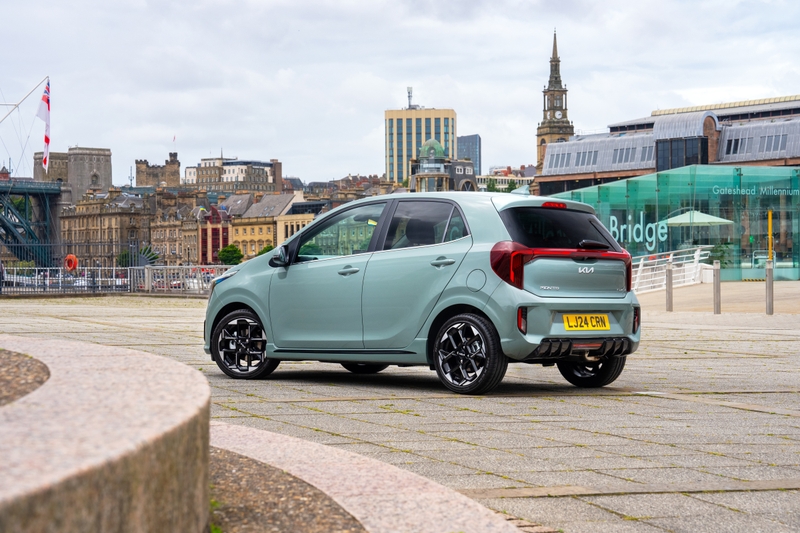








Nissan Micra Review
The Nissan Micra has proved enduringly popular on British roads, with many older examples still in service to this day.
There's no question that the most recent Micra is the best of the lot, with a surprisingly plush cabin compared to most small hatchbacks. It's not without flaws, however, with an unremarkable driving experience and underwhelming practicality. Is the low price tag enough to save it?
- Surprisingly posh cabin
- Decent ride quality
- Excellent value as a used car
- Poor rear-seat space
- Dull to drive
- Engine isn't the smoothest
Should I buy a Nissan Micra?
We mean this in the best way possible – Nissan Micras are like cockroaches. They're almost everywhere – they're hard to kill – and they'd probably survive a nuclear explosion.
Toughness is a valuable quality in a small car, but the latest Nissan Micra also brings other talents to the table. Chief among which is the cabin styling – it's a cut above most small hatches with plush materials and a mature, elegant design. Plus, the paired-back engine range now only includes turbocharged petrol options, so you don't have to thrash the car to hit motorway speeds.
It doesn't score straight-As, however. The back seats are very small, even among similarly sized rivals and the cargo area isn't as useful in practice as its on-paper size might suggest.
Those concerns might melt away, though, when you see how much the Micra costs on used market. It undercuts almost all key rivals on price, meaning you can usually get a newer, lower-mileage, or higher-spec Micra for the same budget.
Interior and technology
Cabin styling is one of the Micra's strong suits – along with quite a few recent Nissan cars we've tried. A prominent, soft-touch panel dominates the dashboard design, with the infotainment screen nestled in a centre-mounted pod. We're particular fans of the suede dash upholstery you'll find in N-Sport models, but other trim levels feature leather or patterned cloth.
The other controls are easy to locate and use, including physical knobs for temperature, fan speed and stereo volume. We also like the fact the centre console unit includes faux stitched fabric trim on either side where your knee tends to rest – this is often made from hard plastic in rival cars.
Newer competitors, however, have worked out that infotainment systems are easier to read when they're mounted on top of the dash – you have to glance a little further down to see the Nissan's screen. The graphics are, at least, clear and easy to read, and the response times to screen prods are reasonably quick.
Practicality
Nissan's done a great job with the cabin's styling but quite a bit of function has been sacrificed for the sake of form. Most direct rivals offer more passenger space, especially in the back seats, which are tighter than the likes of the spacious SEAT Ibiza and even average-sized models like the Ford Fiesta.
The front will accommodate adults, even if they're well over six-foot tall. In this case, however, the seat directly behind them will have almost no legroom at all, so you'll probably have to come to some sort of compromise if you want to fit four fully grown passengers on board. There is a fifth centre-rear seat but it's really there in name only, with elbow room already being in short supply with just two rear occupants.
Cargo space is acceptable for the class but lags behind the Skoda Fabia or Dacia Sandero. The Micra has a reasonably long load area, but the space is a bit narrower than most, so carrying wider objects might prove challenging.
Engines and performance
Since 2020, all Micras come with the same 1.0-litre turbo petrol engine, connected to either a five-speed manual or a CVT-style automatic gearbox. Earlier versions had 100hp while 2021 models onwards have 92hp in pursuit of better economy. We drove the latter and found it to be well matched to the little Micra.
There's a decent amount of punch once the turbocharger gets up to speed, so you won't find yourself hunting through the gearbox if you want a burst of acceleration. It is possible to catch the engine off guard, though, if you press the throttle when the turbo's not spinning fast enough, resulting in a sluggish response while the system takes a moment to wake up.
On occasion, the engine was slightly jerky when applying small amounts of throttle to crawl through traffic. You eventually learn how to tickle the pedal in such a way to smooth it out but, as a result, it doesn't feel quite as intuitive to use as the engine in a Fiesta or Polo.
Driving and comfort
The Micra earns a passing grade on the road, although it can't quite match the Ford Fiesta for overall competence behind the wheel. The chassis is set up to flow down the road rather than dart from corner to corner – great for normal driving – although you get more body roll than some rivals. Nevertheless, the steering is light and accurate enough that it's still easy to position the car on the road.
At least the Micra makes the most of its softer setup with great ride quality by the standards of the class. The suspension substantially softens the impact of road bumps, while also tuning out most of the higher-frequency vibrations you get over scruffy surfaces. Similarly cosseting ride quality can be found in the Renault Clio or Peugeot 208, but both of those cars cost more than the Micra like-for-like on the used market.
























































